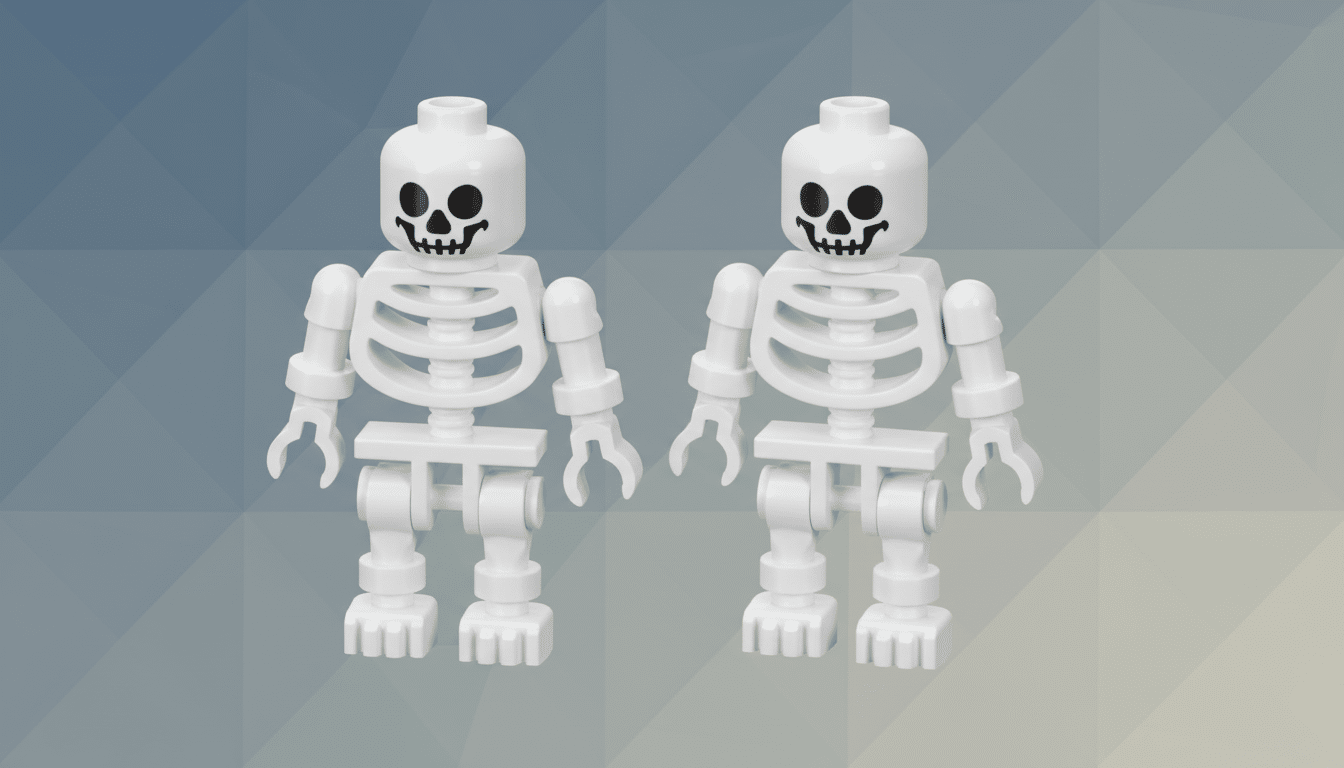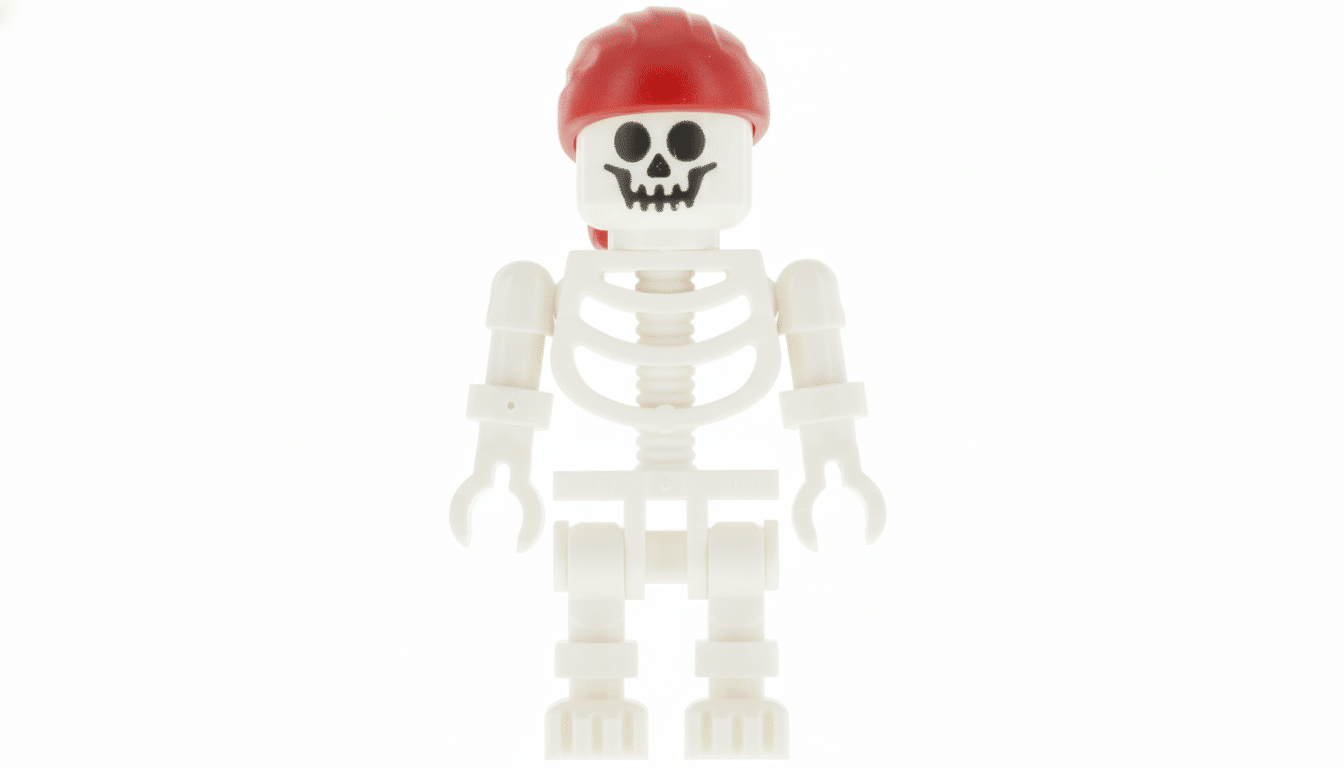A LEGO-inspired skeleton now towers over the block where once there was a suburban yard and, like some playful specter, pulls lines of gawkers followed by a steady stream of camera phones.
Its creator, Alan Perkins of Olmsted Falls, Ohio, has transformed a classic minifigure skeleton into a house-sized spectacle — more than 13 feet tall, with articulated arms that actually move.

Perkins already is a legend in local Halloween circles when it comes to decorative displays. This build, though, takes him to the next level: part engineering flex, part fan tribute and full-on seasonal theater.
A House-Scale Minifig Skeleton Built for Halloween
The idea is disarmingly simple: keep the cartoon-clean proportions of a LEGO skeleton, but blow it up about a hundred times. That means every curve and corner — from the rounded skull to the blocky clavicles — must be translated into structural parts that can withstand outdoor weather, gravity, wind shear.
Most of the skeleton’s structure is carved from foam, Perkins writes in his Instructables tutorial, and hardened with various coatings and paint for strength. The main body is created using wire and PVC to connect the limbs and provide movement at the shoulders. The finishing layer uses Styroplast, a hard coat prop makers use to cover and fill foam before painting.
Both budget- and body-wise, he thinks his materials total around $1,700; a ground-up replica could cost closer to $2,500. For a one-off, custom-made piece at this scale, that number was impressively efficient — especially compared with commercial props of similar size.
How the Build Played Out, From Templates to Assembly
In order to ensure it maintained its shape as accurately as possible, Perkins created templates and custom cutting tools that carved up foam parts that could be adhered together and sanded into clean LEGO-like shapes. Sections were constructed as building blocks — skull, chest, pelvis, limbs — so that the giant could be taken apart and put back together or modified without having to disassemble an entire figure.
The arm articulation is the one area where functionality mattered most. Collapsible PVC sleeved in reinforced sockets, and an interior wire armature support posing of the shoulders without affecting stability. It’s that kind of detail fans instantly recognize as “LEGO correct,” and it gives the display a personality seldom present in static props.
Safety is a design pillar. A 13-foot figurehead has a lot of sail area, so anchoring and weight distribution matter as much for appearance as surface plating. Foam hard-coating, internal bracing and secure tie-down points — all practices that professional scenic fabricators rely on — will help keep the skeleton up when the weather goes sideways, Perkins emphasizes.

Viral Moment and Community Impact of the Display
The display soon escaped the front lawn and was being watched around the world. LEGO’s official Instagram highlighted the build, receiving more than 185,000 likes (and counting) and a deluge of comments inquiring about how to buy one. The answer, of course, is that you don’t — you build it, or admire the handiwork of someone else who can.
Perkins coupled the attention with some purpose, of course, by becoming a part of Skeletons of St. Jude, a national homespun campaign that has households decorate with skeletons and make donations on behalf of St. Jude Children’s Research Hospital to help support its mission. Organizers say the initiative now boasts more than 650 participating homes and that what started as neighborhood decoration has turned into a meaningful fundraiser.
Why This Skeleton Hits Different for Fans and Neighbors
Giant Halloween props are crushing it; retailers have shown that there’s an appetite for yard-scale centerpieces with viral powerhouses such as Home Depot’s 12-foot “Skelly.” But Perkins’ LEGO-inspired view hits on something even more than spectacle: nostalgia, toy culture, and the care and attention to detail that is maker craft.
There’s also a data-driven reason fans are always eager for bold pronouncements. Recent research from the National Retail Federation found that spook season spending is expected to rival, and possibly exceed, $12 billion overall, with outdoor decorations being one of the fastest-growing categories. When everybody’s doing it, standing out requires either cleverness or some serious scale. Perkins chose both.
For the inspired DIYer, the full build provides a map and reality check. Foam carving and hard-coating are achievable with patience and safety gear, but articulation, anchoring and weatherproofing make things complicated. If you’re a beginner, consider a smaller figure, experiment with some coatings on odd scraps of foam and be sure to look up local codes for large displays. For everyone else, mass-market showpieces and licensed LEGO Halloween sets are still a reliable path to curb appeal without the workshop marathon.
And in the end, it’s why the house-tall skeleton made of LEGO works: because it is joyful and a little bit bold.
It transforms a silent yard into a seasonal spectacle, signals the culture of building, and channels all that energy toward a cause worth supporting. It’s that sweet spot where Halloween decor becomes a communal effort, rather than just something you stick in your yard.

